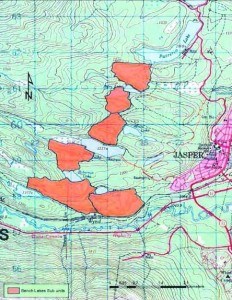
Early indications suggest the mountain pine beetle may be feeling the effects of the frigid weather that gripped Jasper and much the Rockies in mid-December and early January.
Dave Smith, a fire and vegetation specialist for Parks Canada, said it appears the beetle’s larvae did not survive the cold weather.
“What I’ve found so far is a lot of dead beetle, but I certainly can’t go out on a limb and say the beetle problems are gone, because that’s far from the case,” said Smith.
“The sample size I’ve taken is very small and it’s not widespread so I can’t begin to make any conclusions.”
The mountain pine beetle is native to North America, however in recent years it has expanded beyond its traditional range, extending further north in British Columbia and further northeast into Alberta.
The tiny beetle survives by burrowing under the bark of pine trees and mining the phloem, the layer between the bark and wood of the tree. The beetles then lay eggs under the bark. After the eggs hatch, the grub-like larvae spend the winter feeding under the bark.
The larvae pupate in the spring and emerge as adults usually from June 15 to July 1 before moving on to the next mature pine tree.
The successful reproduction of the mountain pine beetle depends on several factors, including daily temperature fluctuations, under-bark temperatures and the ‘winter-readiness’ of beetle larvae.
“The beetles have always been here but the thing that’s always kept them at bay has been our cold winters and with three or four years without those cold winters the beetle has been able to get far more than a toe hold–they’re here,” said Smith.
According to the province, the temperature at which beetles start to die is not fixed, but varies given the larvae’s response to daily temperature fluctuations.
For example, an under-bark temperature of –37 C will kill 50 per cent of a mountain pine beetle population, however, a temperature of –20 C in the fall, before the beetles are prepared for winter, or in the spring, when beetles are starting to become more active, will also kill beetles if it is preceded by temperatures above 0 C.
From Dec. 5 to Dec. 18 temperatures in Jasper hovered between -19 C and -35 C at the coldest points of the day. Temperatures dropped again during the first two weeks of January, hitting a low of -34 C on Jan. 3.
“This winter being a little more normal, there’s some good indications that at least some of the beetle will be slowed down,” said Smith, explaining that those that die will not be able to colonize new trees in the summer.
He said the true impact of the cold weather won’t be known until the fall when the colonized trees begin to die.
“There’s a lag time between the time the beetle attacks a tree and gets inside the tree and when the tree starts to show itself as dying or what we call fading. It starts to turn from the nice bright green to a yellow and the final phase is, of course, red.”
The ratio between the number of trees that are attacked from a single colonized tree varies from place to place, but in some cases a single colonized tree can infest 40 healthy trees in a single season.

In March 2016, Parks Canada reported the beetle colonized more than , more than three times the amount mapped in 2014. A year earlier the agency mapped 122 hectares.
To slow the eastward spread of the beetle, . The plan includes using prescribed burns, cutting down individual and multiple trees and using harvesting equipment to eliminate larger patches of infected forest.
According to Smith, the prescribe burns are intended to kill beetle habitat before they arrive and to eliminate fuel in the event of a wildfire.
Currently his team is preparing to carry out prescribed burns in two different areas of the park–on Pyramid Bench and in the Fiddle Creek area, near the east gate. His team has also been carrying out fire smart work behind Cabin Creek in the west end of town in recent weeks.
“Jasper is better situated from a protection point of view than most places in Alberta because of all the fire smarting,” said Smith.
Parks Canada was hoping to begin burning the six units on Pyramid Bench last fall but due to inclement weather conditions was unable to. The plan is to try again in the spring.
In the Fiddle Creek area, crews have also been busy putting fireguards in place in anticipation of carrying out a prescribed burn in the Fiddlewest fire unit, between Highway 16, the Athabasca River and Fiddle Creek.
“We can only burn when we are in prescription so we have to prepare ourselves to be ready to go if those conditions are given to us by Mother Nature,” said Smith. “We want to see that happen this year. We’ve got everything in place and we’re ready to go.”
Paul Clarke
[email protected]
